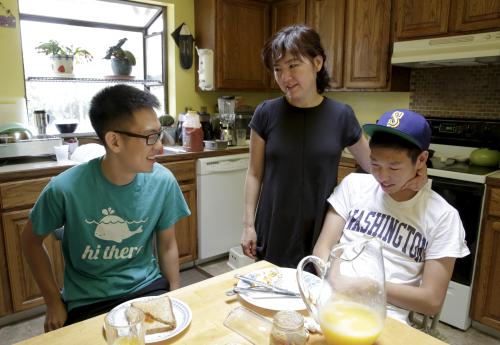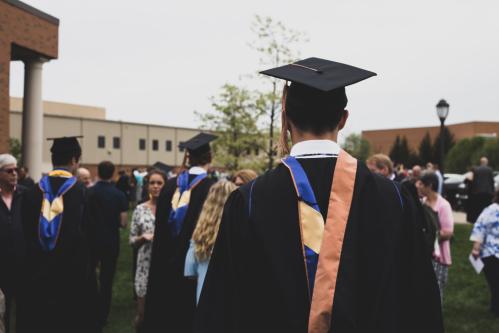Forty-two million Americans, or one in every eight, have student loans, and they owe a total of $1.6 trillion, the second largest pool of consumer credit after mortgages. According to the Federal Reserve, 20 percent of adult borrowers who borrowed for their own educations were behind on their payments in 2018. Of those who are paying their loans, typical monthly payments are between $200 and $299. With unemployment soaring due to the coronavirus pandemic, some people may not be able to make their monthly loan payments. What has the government done to relieve the burden of student loans?
What has been done so far directly for borrowers?
The Coronavirus Aid, Relief, and Economic Security (CARES) Act temporarily suspends monthly payments (technically “administrative forbearance”) on all loans held by the Department of Education, from March 13, 2020, through September 30, 2020. The suspension will be automatic; borrowers do not have to apply for relief, although individuals can still choose to make monthly payments. For borrowers in default, the bill stops the involuntary collection of payments through wage garnishment and seizure of tax refunds until the end of September. The law also sets the interest rate at zero percent during this time period.
Who will this affect?
The relief offered through the CARES Act only benefits federal loan borrowers, and specifically loans held by the Department of Education. Direct Loans—which account for about 3/4 of all student debt—qualify, but many Federal Family Education Loan (FFEL) Loans and Perkins loans do not. For example, roughly 2/3 of FFEL debt is ineligible for the student loan forbearance in the CARES Act. In addition, about 8 percent of student loan debt is private and also does not qualify.
Individuals already enrolled in forgiveness programs, such as Public Service Loan Forgiveness (PSLF) and Income-Driven Repayment (IDR) programs, will still benefit from the forbearance program. The Income-Based Repayment plan, for example, requires borrowers to make monthly payments equal to 10 percent of their discretionary income for 20 or 25 years; any remaining balance is forgiven. For borrowers enrolled in this program, the government will treat the skipped payments as if they were made.
How are parents or families with loans affected?
Six percent of loans are owned by parents and guardians through the Parent PLUS loan program–$96 billion of outstanding debt, as of the first quarter of 2020. If a parent or a guardian, as defined by the Department of Education, has a Direct PLUS Loan, then forbearance and interest relief is automatic for the next six months. Other loans taken by families, such as through the FFEL Loan program, may also qualify if they are currently held by the Department of Education.
What do these measures accomplish?
The student loan provisions in the CARES Act address the cash flow issues that stem from temporary losses of income and wages, but the help is also mostly temporary—although no interest accrues over the next six months, principal payments that would have been due during this period are delayed, not forgiven. Furthermore, only about half of all borrowers are currently making loan payments, with the remainder still in school, in default, or not required to make payments for other reasons. While many of these borrowers benefit from the zero interest rate, they don’t get any benefit from the suspension of benefits (since they wouldn’t be making payments over the next six months anyhow).
But for individuals in an income-driven plan, about 20 percent of borrowers, forbearance offers permanent benefits, as they won’t have to make payments for the next 6 months and can still receive forgiveness at the end of the time period (after 20 or 25 years). In addition, individuals seeking Public Service Loan Forgiveness can have their loans forgiven after 10 years; for these borrowers, this provision can eliminate 5 percent of the burden they face.
What about employers?
Employers long have been permitted to provide employees $5,250 in tax-free income to cover tuition costs. Under the CARES Act, that money can also be used to cover student-loan payments, so long as the payments are made before December 31, 2020. Our colleague Adam Looney argues that this provision will primarily help high-income borrowers, because only those with a job and an employer that offers generous benefits will be able to take advantage of it.
What additional relief may be on the way?
While the student loan measures included in the CARES Act are helpful, many believe they don’t go far enough. House Democrats, for example, had included a provision to cancel $10,000 in loans for all borrowers in their version of the coronavirus response bill. Such a provision would help cushion the blow of the loss of income many borrowers are likely to experience as a result of the pandemic.
Cancelling up to $10,000 of student debt would immediately eliminate the entire balance for 35 percent of borrowers. The Student Loan Borrower Assistance Project at the National Consumer Law Center is advocating for this relief “to ensure financial relief and economic recovery for those already burdened by debt.” But others note that this policy will disproportionately benefit middle and upper-income households, as they tend to hold more student debt.
In addition, many advocates are asking that private lenders also suspend student loan payments during the pandemic. A group of 12 Senators recently sent a letter to private lenders asking them to offer the same relief available in the CARES Act to their borrowers, as well as cancelling delinquent loans and assuring no negative consequences for cosigners. Such relief, if offered, would affect about 8 percent of student loan debt.
Presidential candidate and former Vice President Joe Biden supports immediate cancellation of at least $10,000 in student debt. His proposal also includes forgiving all student debt related to undergraduate tuition for individuals who earn less than $125,0000 and who attended public two-year and four-year schools, and private Historically Black Colleges and Minority-Serving Institutions.
The Brookings Institution is committed to quality, independence, and impact.
We are supported by a diverse array of funders. In line with our values and policies, each Brookings publication represents the sole views of its author(s).








Commentary
What’s the government done to relieve student loan borrowers of their burden during the corona crisis?
April 16, 2020